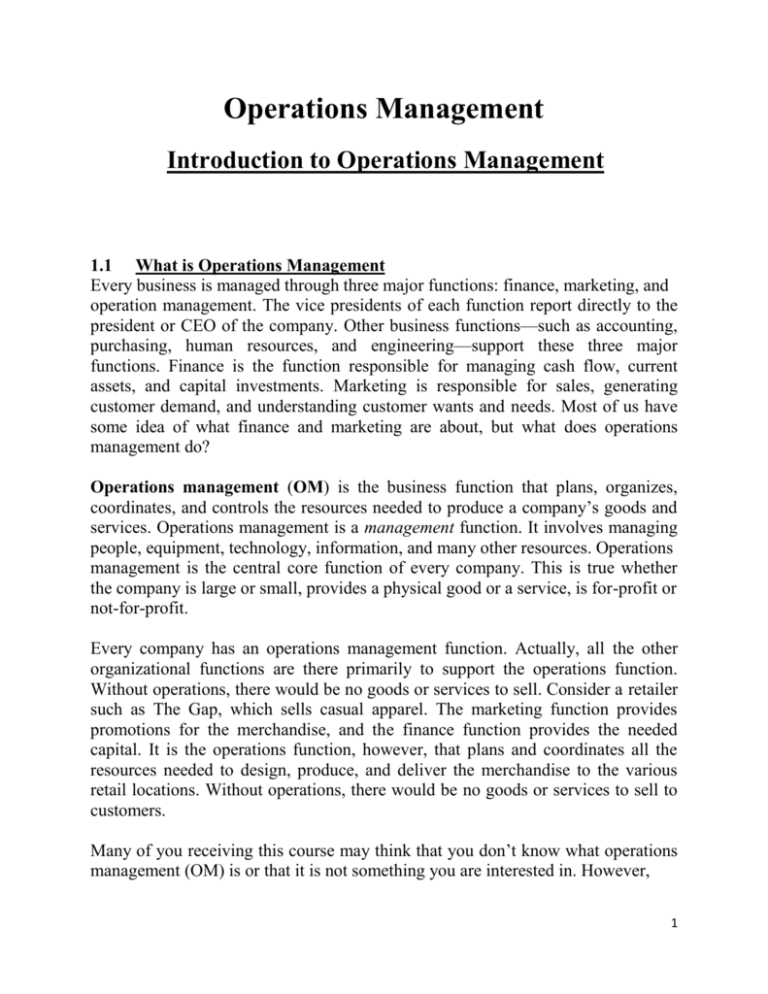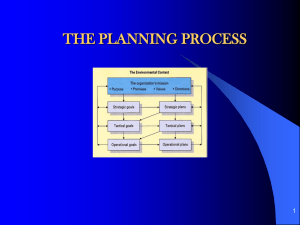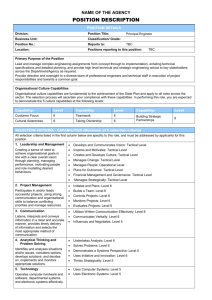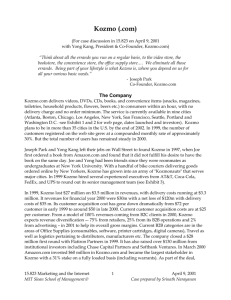Operations Management
advertisement

Operations Management Introduction to Operations Management 1.1 What is Operations Management Every business is managed through three major functions: finance, marketing, and operation management. The vice presidents of each function report directly to the president or CEO of the company. Other business functions—such as accounting, purchasing, human resources, and engineering—support these three major functions. Finance is the function responsible for managing cash flow, current assets, and capital investments. Marketing is responsible for sales, generating customer demand, and understanding customer wants and needs. Most of us have some idea of what finance and marketing are about, but what does operations management do? Operations management (OM) is the business function that plans, organizes, coordinates, and controls the resources needed to produce a company’s goods and services. Operations management is a management function. It involves managing people, equipment, technology, information, and many other resources. Operations management is the central core function of every company. This is true whether the company is large or small, provides a physical good or a service, is for-profit or not-for-profit. Every company has an operations management function. Actually, all the other organizational functions are there primarily to support the operations function. Without operations, there would be no goods or services to sell. Consider a retailer such as The Gap, which sells casual apparel. The marketing function provides promotions for the merchandise, and the finance function provides the needed capital. It is the operations function, however, that plans and coordinates all the resources needed to design, produce, and deliver the merchandise to the various retail locations. Without operations, there would be no goods or services to sell to customers. Many of you receiving this course may think that you don’t know what operations management (OM) is or that it is not something you are interested in. However, 1 after reading this lesson you will realize that you already know quite a bit about operations management. You may even be working in an operations management capacity and have used certain operations management techniques. You will also realize that operations management is probably the most critical business function today. If you want to be on the frontier of business competition, you want to be in operations management. Today companies are competing in a very different environment than they were only a few years ago. To survive, they must focus on quality, time-based competition, efficiency, international perspectives, and customer relationships. Global competition, e-business, the Internet, and advances in technology require flexibility and responsiveness. Increased financial pressures require lean and agile organizations that are free of waste. This new focus has placed operations management in the business limelight because it is the function through which companies can achieve this type of competitiveness. Consider some of today’s most successful companies, such as Wal-Mart, Southwest Airlines, General Electric, Starbucks, Apple Computer, Toyota, FedEx, and Procter & Gamble. These companies have achieved world-class status in large part due to a strong focus on operations management. In this book you will learn specific tools and techniques of operations management that have helped these and other companies achieve their success. The purpose of this lesson is to help prepare you to be successful in this new business environment. Operations management will give you an understanding of how to help your organization gain a competitive advantage in the marketplace. Regardless of whether your area of expertise is marketing, finance, MIS, or operations, the techniques and concepts in this book will help you in your business career. The material will teach you how your company can offer goods and services cheaper, better, and faster. You will also learn that operations management concepts are far-reaching, affecting every aspect of the organization and even everyday life. 1.2 The Role of Operations Management The role of operations management is to transform a company’s inputs into the finished goods or services. Inputs include human resources (such as workers and managers), facilities and processes (such as buildings and equipment), as well as materials, technology, and information. Outputs are the goods and services a company produces. At a factory the transformation is the physical change of raw 2 materials into products, such as transforming leather and rubber into sneakers, denim into jeans, or plastic into toys. At an airline it is the efficient movement of passengers and their luggage from one location to another. At a hospital it is organizing resources such as doctors, medical procedures, and medications to transform sick people into healthy ones. Operations management is responsible for orchestrating all the resources needed to produce the final product. This includes designing the product; deciding what resources are needed; arranging schedules, equipment, and facilities; managing inventory; controlling quality; designing the jobs to make the product; and designing work methods. Basically, operations management is responsible for all aspects of the process of transforming inputs into outputs. Customer feedback and performance information are used to continually adjust the inputs, the transformation process, and characteristics of the outputs. Proper management of the operations function has led to success for many companies. For example, in 1994 Dell Computer Corporation was a second-rate computer maker that managed its operations similarly to others in the industry. Then Dell implemented a new business model that completely changed the role of its operations function. Dell developed new and innovative ways of managing the operations function that have become one of today’s best practices. These changes enabled Dell to provide rapid product delivery of customized products to customers at a lower cost. Today Dell customized computers can be en route to the customer within 36 hours, at a price 10–15 percent lower than industry standard. Dell’s model is one many have tried to emulate and is the key to its being an industry leader. Just as proper management of operations can lead to company success, improper management of operations can lead to failure. This is illustrated by Kozmo.com, a Web-based home delivery company founded in 1997. Kozmo’s mission was to deliver products to customers—everything from the latest video to ice cream—in less than an hour. Kozmo was technology enabled and rapidly became a huge success. However, the initial success gave rise to overly fast expansion. The company found it difficult to manage the operations needed in order to deliver the promises made on its Web site. The consequences were too much inventory, poor deliveries, and losses in profits. The company rapidly tried to change its operations, but it was too late. It had to cease operations in April 2001. The Web-based age has created a highly competitive world of on-line shopping that poses special challenges for operations management. The Web can be used for 3 on-line purchasing of everything from CDs, books, and groceries to prescription medications and automobiles. The Internet has given consumers flexibility; it has also created one of the biggest challenges for companies: delivering exactly what the customer ordered at the time promised. As we saw with the example of Kozmo.com, making promises on a Web site is one thing; delivering on those promises is yet another. Ensuring that orders are delivered from “mouse to house” is the job of operations and is much more complicated than it might seem. In the 1990s many dot-com companies discovered just how difficult this is. They were not able to generate a profit and went out of business. To ensure meeting promises, companies must forecast what customers want and maintain adequate inventories of goods, manage distribution centers and warehouses, operate fleets of trucks, and schedule deliveries while keeping costs low and customers satisfied. Many companies like Amazon.com manage almost all aspects of their operation. Other companies hire outside firms for certain functions, such as outsourcing the management of inventories and deliveries to UPS. Competition among e-tailers has become intense as customers demand increasingly shorter delivery times and highly customized products. Same-day service has become common in metropolitan areas. For example, Barnesandnoble.com provides same-day delivery in Manhattan, Los Angeles, and San Francisco. Understanding and managing the operations function of an on-line business has become essential in order to remain competitive. For operations management to be successful, it must add value during the transformation process. We use the term value added to describe the net increase between the final value of a product and the value of all the inputs. The greater the value added, the more productive a business is. An obvious way to add value is to reduce the cost of activities in the transformation process. Activities that do not add value are considered a waste; these include certain jobs, equipment, and processes. In addition to value added, operations must be efficient. Efficiency means being able to perform activities well and at the lowest possible cost. An important role of operations is to analyze all activities, eliminate those that do not add value, and restructure processes and jobs to achieve greater efficiency. Because today’s business environment is more competitive than ever, the role of operations management has become the focal point of efforts to increase competitiveness by improving value added and efficiency. 4 1.3 Differences between Manufacturing & Serving Organization Organizations can be divided into two broad categories: manufacturing organizations and service organizations, each posing unique challenges for the operations function. There are two primary distinctions between these categories. First, manufacturing organizations produce physical, tangible goods that can be stored in inventory before they are needed. By contrast, service organizations produce intangible products that cannot be produced ahead of time. Second, in manufacturing organizations most customers have no direct contact with the operation. Customer contact occurs through distributors and retailers. For example, a customer buying a car at a car dealership never comes into contact with the automobile factory. However, in service organizations the customers are typically present during the creation of the service. Hospitals, colleges, theaters, and barber shops are examples of service organizations in which the customer is present during the creation of the service. The differences between manufacturing and service organizations are not as clearcut as they might appear, and there is much overlap between them. Most manufacturers provide services as part of their business, and many service firms manufacture physical goods that they deliver to their customers or consume during service delivery. For example, a manufacturer of furniture may also provide shipment of goods and assembly of furniture. A barber shop may sell its own line of hair care products. You might not know that General Motors’ greatest return on capital does not come from selling cars, but rather from post sales parts and service. The differences between manufacturing and services, focusing on the dimensions of product tangibility and the degree of customer contact. It shows the extremes of pure manufacturing and pure service, as well as the overlap between them. Even in pure service companies some segments of the operation may have low customer contact while others have high customer contact. The former can be thought of as “back room” or “behind the scenes” segments. Think of a fast-food operation such as Wendy’s, for which customer service and customer contact are important parts of the business. However, the kitchen segment of Wendy’s operation has no direct customer contact and can be managed like a manufacturing operation. Similarly, a hospital is a high-contact service operation, but the patient is not present in certain segments, such as the lab where specimen analysis is done. In addition to pure manufacturing and pure service, there are companies that have some characteristics of each type of organization. It is difficult to tell whether these 5 companies are actually manufacturing or service organizations. Think of a post office, an automated warehouse, or a mail-order catalog business. They have low customer contact and are capital intensive, yet they provide a service. We call these companies quasi-manufacturing organizations. The U.S. Postal Service is an example of a quasi-manufacturing type of company. It provides a service: speedy, reliable delivery of letters, documents, and packages. Its output is intangible and cannot be stored in inventory. Yet most operations management decisions made at the Postal Service are similar to those that occur in manufacturing. Customer contact is low, and at any one time there is a large amount of inventory. The Postal Service is capital intensive, having its own facilities and fleet of trucks and relying on scanners to sort packages and track customer orders. Scheduling enough workers at peak processing times is a major concern, as is planning delivery schedules. Note that although the output of the U.S. Postal Service is a service, inputs include labor, technology, and equipment. The responsibility of OM is to manage the conversion of these inputs into the desired outputs. Proper management of the OM function is critical to the success of the U.S. Postal Service. It is important to understand how to manage both service and manufacturing operations. However, managing service operations is of especially high importance. The reason is that the service sector constitutes a dominant segment of our economy. Since the 1960s, the percentage of jobs in the service-producing industries of the U.S. economy has increased from less than 50 to over 80 percent of total nonfarm jobs. The remaining 20 percent are in the manufacturing and goods-producing industries. 1.4 Operations Management Decisions In this section we look at some of the specific decisions that operations managers have to make. The best way to do this is to think about decisions we would need to make if we started our own company—say, a company called Gourmet Wafers that produces praline–pecan cookies from an old family recipe. Think about the decisions that would have to be made to go from the initial idea to actual production of the product: that is operations management. The first decisions are made very broad in scope (e.g., the unique features of our product). We needed to do this before we could focus on more specific decisions (e.g., worker schedules). Although our example is simple, this decision-making process is followed by every company, including IBM, General Motors, Lands’ End, and your local floral shop. Also note in our example that before we can think 6 about specific day-to-day decisions, we need to make decisions for the whole company that are long-term in nature. Long-term decisions that set the direction for the entire organization are called strategic decisions. They are broad in scope and set the tone for other, more specific decisions. They address questions such as: What are the unique features of our product? What market do we plan to compete in? What do we believe will be the demand for our product? 1.5 Tactical Decisions Short-term decisions that focus on specific departments and tasks are called tactical decisions. Tactical decisions focus on more specific day-to-day issues, such as the quantities and timing of specific resources. Strategic decisions are made first and determine the direction of tactical decisions, which are made more frequently and routinely. Therefore, we have to start with strategic decisions and then move on to tactical decisions. Tactical decisions must be aligned with strategic decisions because they are the key to the company’s effectiveness in the long run. Tactical decisions provide feedback to strategic decisions, which can be modified accordingly. You can see in the example of Gourmet Wafers how important OM decisions are. They are critical to all types of companies, large and small. In large companies these decisions are more complex because of the size and scope of the organization. Large companies typically produce a greater variety of products, have multiple location sites, and often use domestic and international suppliers. Managing OM decisions and coordinating efforts can be a complicated task, and the OM function is critical to the company’s success. We can illustrate this point by looking at operations management decisions made by Texas Instruments (TI) in order to position itself for global collaboration with customers, distributors, and suppliers. TI realized its business was growing exponentially, with more than 120,000 monthly orders received and processed electronically. The coordination effort encompassed 56 factories, including subcontractors, and the management of over 45,000 products. To succeed, the company needed to develop a system to generate better forecasts, coordinate manufacturing of products, manage orders, and track deliveries. Managing and coordinating global operations management functions was considered paramount to the company’s success. 7 TI adopted a comprehensive software package called enterprise resource planning (ERP) that integrates information throughout the organization, manages forecasts, and coordinates factory operations. Designing and implementing the ERP system at TI required an understanding of all the strategic and tactical operations decisions; otherwise, it would not be effective. The system has proven to be a success and a major achievement, enabling TI to consistently manage factory operations across the globe. The purpose here is to provide concepts and techniques that give you the ability to efficiently plan, order, and control the resources needed to produce a company’s goods and services. We begin with broad, overarching issues such as product design and process selection. Also early on we cover operations topics that require a strategic perspective and a cultural change within the organization, such as supply chain management, total quality management, and just-in-time systems. We progress to more tactical issues, such as work measurement, inventory management, and scheduling concerns. We have designed the chapters to provide relevant operations management concepts and techniques that are important to business professionals regardless of their field of study. Throughout the chapters we show how the tools and concepts discussed relate to other functions in the organization and that operations management concepts are far-reaching, affecting every aspect of the organization. 1.6 Understanding Operations Management You should understand that operations management (OM) is the business function responsible for planning, coordinating, and controlling the resources needed to produce a company’s goods and services. OM is directly responsible for managing the transformation of a company’s inputs (e.g., materials, technology, and information) into finished products and services. OM requires a wide range of strategic and tactical decisions. Strategic decisions are long-range and very broad in scope (e.g., unique features of the company’s product and process). They determine the direction of tactical decisions, which are more short term and narrow in scope (e.g., policy for ordering raw materials). All organizations can be separated into manufacturing and service operations, which differ based on product tangibility and degree of customer contact. Service and manufacturing organizations have very different operational requirements. 8










